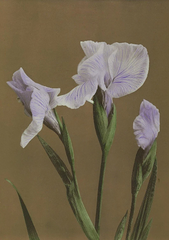Exploring the legacy of Japanese art
Share
Japanese art, steeped in a rich tapestry of cultural heritage, includes an array of masterpieces that transcend time and place. Within this realm of artistic excellence, luminaries such as Ohara Koson, Hiroaki Takahashi, Tsukioka Yoshitoshi, Kazumasa Ogawa, and others shine brightly, each contributing a unique facet to Japan's artistic legacy. Their works, marked by intricate themes, innovative techniques, and distinctive styles, continue to captivate audiences worldwide, serving as windows into Japan's past, present, and future.
Ohara Koson, recognised for his mastery of the woodblock print technique, invites viewers into the ethereal landscapes of nature. His prints, depicting serene scenes of delicate flora and fauna, evoke a sense of tranquility and harmony. Working primarily in the late 19th and early 20th centuries during Japan's Meiji and Taisho periods, Koson's art reflects a period of transition marked by the country's rapid modernisation and its enduring connection to the natural world.
In contrast, Hiroaki Takahashi's vibrant compositions often pulsate with the dynamic energy of urban life. Another master of the woodblock technique, Takahashi captures the essence of landscapes, harbours, and the city, bringing scenes to life for a series of souvenir prints he was recruited to produce, to meet western demand. Working predominantly in the early 20th century, Takahashi's woodblocks were destroyed in the Great Kanto earthquake of 1923, and had to be reproduced.
Tsukioka Yoshitoshi delves into the realm of the surreal and supernatural, exploring themes of mythology, folklore, and the human psyche. His bold imagination and masterful draftsmanship give rise to hauntingly beautiful imagery that transcends the boundaries of reality. Operating during the late Edo period and into the Meiji era, Yoshitoshi's works reflect a period of political upheaval and cultural transformation, offering a glimpse into Japan's turbulent transition from feudalism to modernity.
Kazumasa Ogawa's art exudes elegance and refinement, paying homage to traditional Japanese motifs with intricate designs. A photographer working in the late 19th and early 20th centuries, Ogawa was a pioneer of photomechanical techniques and his artworks celebrate the landscapes and people of Japan and Korea, as well as the timeless beauty of nature. A founding member of the Japan Photographic Society, Ogawa created images that serve as a testament to the enduring appeal of Japanese aesthetics.
What unites these artists and elevates their works is their ability to blend tradition with innovation. Drawing inspiration from centuries-old techniques while pushing the boundaries of artistic expression, they breathe new life into Japan's artistic traditions, ensuring their relevance in an ever-changing world. Whether capturing the tranquility of nature, the vitality of urban life, the mysteries of the human psyche, or the elegance of tradition, each artist contributes a unique perspective to Japan's artistic tapestry, enriching it with their individual voices.



